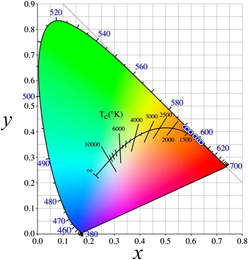Crossref Citations
This article has been cited by the following publications. This list is generated based on data provided by
Crossref.
Li, ShuXing
Liu, XueJian
Mao, RiHua
Huang, ZhengRen
and
Xie, RongJun
2015.
Red-emission enhancement of the CaAlSiN3:Eu2+ phosphor by partial substitution for Ca3N2 by CaCO3 and excess calcium source addition.
RSC Advances,
Vol. 5,
Issue. 93,
p.
76507.
Chung, Shyan-Lung
and
Huang, Shu-Chi
2016.
Effects of Ca Content on Formation and Photoluminescence Properties of CaAlSiN3:Eu2+ Phosphor by Combustion Synthesis.
Materials,
Vol. 9,
Issue. 3,
p.
178.
Oh, Ji Hye
Eo, Yun Jae
Yoon, Hee Chang
Huh, Young-Duk
and
Do, Young Rag
2016.
Evaluation of new color metrics: guidelines for developing narrow-band red phosphors for WLEDs.
Journal of Materials Chemistry C,
Vol. 4,
Issue. 36,
p.
8326.
Liu, Wen-Quan
Wu, Dan
Chang, Hugejile
Duan, Ru-Xia
Wu, Wen-Jie
Amu, Guleng
Chao, Ke-Fu
Bao, Fu-Quan
and
Tegus, Ojiyed
2018.
The Enhanced Red Emission and Improved Thermal Stability of CaAlSiN3:Eu2+ Phosphors by Using Nano-EuB6 as Raw Material.
Nanomaterials,
Vol. 8,
Issue. 2,
p.
66.
Zhuo, Ningze
Zhang, Na
Chen, Peng
and
Wang, Haibo
2019.
Enhancement of efficiency and CCT uniformity for red phosphor thin films, red LEDs and laminated white LEDs based on near-ultraviolet LEDs using MgO nanoparticles.
RSC Advances,
Vol. 9,
Issue. 48,
p.
28291.
Zhao, Yujie
Yin, Liangjun
ten Kate, O. M.
Dierre, Benjamin
Abellon, Ruben
Xie, Rong-Jun
van Ommen, J. Ruud
and
Hintzen, H. T.
2019.
Enhanced thermal degradation stability of the Sr2Si5N8:Eu2+ phosphor by ultra-thin Al2O3 coating through the atomic layer deposition technique in a fluidized bed reactor.
Journal of Materials Chemistry C,
Vol. 7,
Issue. 19,
p.
5772.
Wang, Haohao
Liu, Yujie
Zhu, Xudong
Wei, Liangshu
Jiang, Xiping
Chen, Yong
and
Li, Langkai
2020.
Preparation of CaAlSiN3:Eu2+ red-emitting phosphor by a two-step method for solid-state lighting applications.
Ceramics International,
Vol. 46,
Issue. 14,
p.
23035.
Fan, Jiajie
Zhou, Ling
Cui, Zhen
Chen, Shanghuan
Fan, Xuejun
and
Zhang, Guoqi
2020.
Hydrolysis kinetic study of CaAlSiN3:Eu2+ red phosphor with both water immersion test and first-principles calculation.
Journal of Luminescence,
Vol. 219,
Issue. ,
p.
116874.
Cui, Zhen
Fan, Jiajie
van Ginkel, Hendrik Joost
Fan, Xuejun
and
Zhang, Guoqi
2020.
The interface adhesion of CaAlSiN3: Eu2+ phosphor/silicone used in light-emitting diode packaging: A first principles study.
Applied Surface Science,
Vol. 510,
Issue. ,
p.
145251.
Fang, Mu-Huai
Li, Tian-Yin
Huang, Wen-Tse
Cheng, Chiao-Ling
Bao, Zhen
Majewska, Natalia
Mahlik, Sebastian
Yang, Chia-Wei
Lu, Kuang-Mao
Leniec, Grzegorz
Kaczmarek, Slawomir M.
Sheu, Hwo-Shuenn
and
Liu, Ru-Shi
2021.
Surface-Protected High-Efficiency Nanophosphors via Space-Limited Ship-in-a-Bottle Synthesis for Broadband Near-Infrared Mini-Light-Emitting Diodes.
ACS Energy Letters,
Vol. 6,
Issue. 2,
p.
659.
Huang, Shu-Chi
and
Chung, Shyan-Lung
2021.
Effects of Variation in Al Content on the Emission of Eu Doped CaAlSiN3 Red Phosphor Synthesized by Combustion Synthesis Method for White LEDs.
International Journal of Molecular Sciences,
Vol. 22,
Issue. 20,
p.
11301.
Sun, Bei
Wu, Yelong
Li, Qiangxian
Wu, Lina
and
Yu, Jinying
2023.
White Light Emission and Energy Transfer in CaHf4(PO4)6: Ce3+, Dy3+
.
ECS Journal of Solid State Science and Technology,
Vol. 12,
Issue. 3,
p.
036002.
Ma, Nan
Zhang, Zongjie
Li, Wei
and
Huang, Xiaoyong
2023.
Efficient blue-light-excited cyan-emitting CaLu2HfScAl3O12:Ce3+ phosphors for full-visible-spectrum warm-white LEDs.
Journal of Luminescence,
Vol. 263,
Issue. ,
p.
120060.
